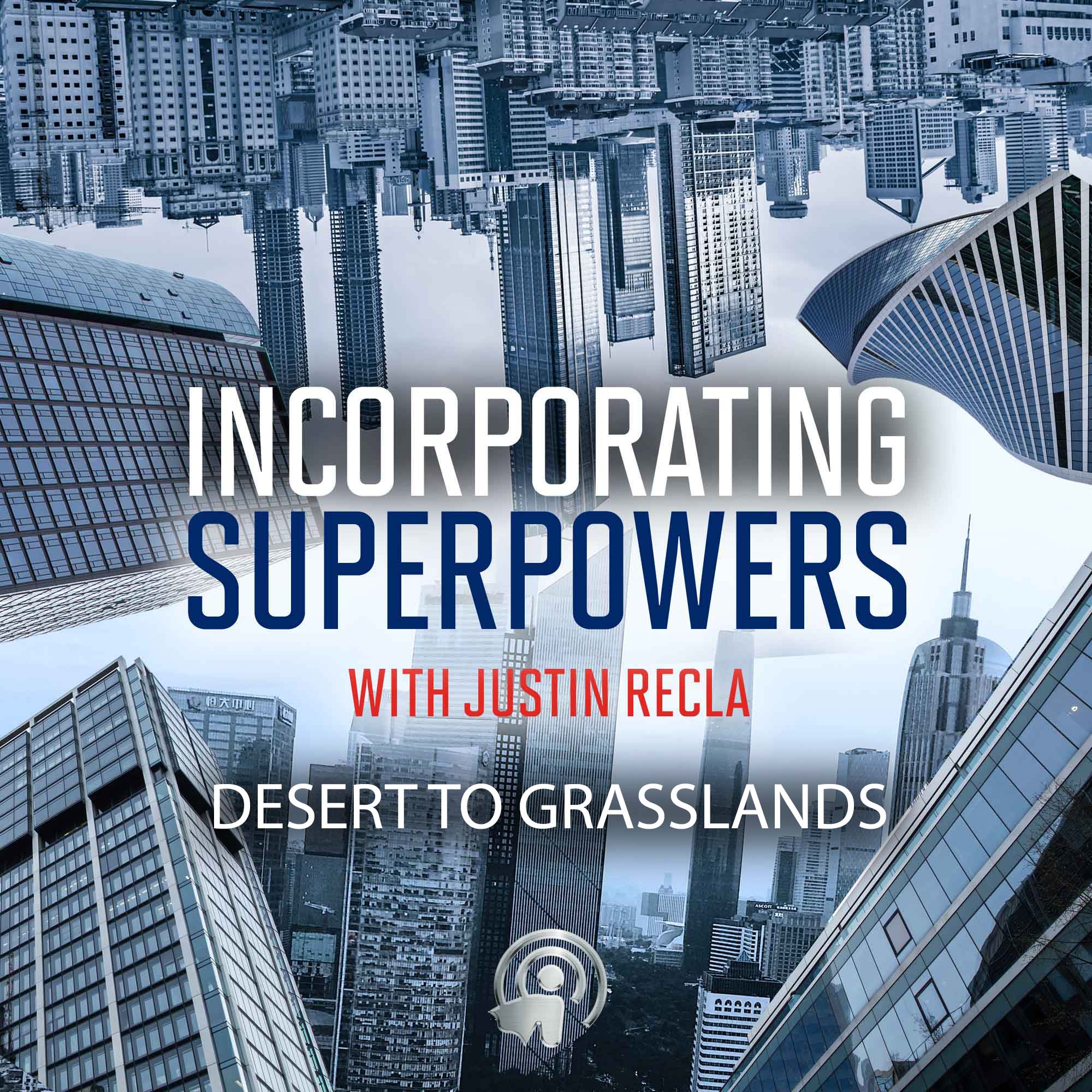
Desert to Grasslands
How can we start converting desert to grasslands? In this episode of Incorporating Superpowers, host Justin Recla welcomes guest Rodger Savory to the show. Rodger is Competing for the X-prize for Carbon removal hosted by Musk Foundation. His company is working on turning the world into a greener, brighter planet. Tune in today to learn about converting desert to grasslands, and changing the planet one day at a time.
Justin Recla:
Welcome to Incorporating Superpowers. Today we’re going to look at something a little bit different than we normally do. Because my guest is actually leading a team that is competing for the XPRIZE. put on by the musk Foundation, and it’s all about carbon removal and get this folks. His team is called Desert to grasslands. And this is going to be a super fun conversation because I spent some time in the desert. Been there back but Afghanistan has been to some really uninhabitable parts of the planet that you know when I was there as they can Well, you, it’d be really nice if it what that would look like at even a global scale. I haven’t even imagined stating what that would look like. But my guest today has please welcome Rodger Savory to the show today. Rodger, I’m excited to hear more about what you and your team are up to, and definitely be rooting for you for the XPRIZE.
Rodger Savory:
Thanks for the invite. It’s a pleasure to be here. Yes, any of us who have Iraqi dinars in our sights? No, no, the value of turning deserts and the grasslands, and the rest of the team’s name is actually feeding the future. Because that’s, we’ve, we’ve got a, we’ve got a billion hungry people on the planet right now, today. And within the next 25 years, there will be another billion. So we can’t feed the current billion and there are about to be 2 billion hungry souls on the planet going to bed hungry every night. And as a Christian, you know that that is just unacceptable?
Justin Recla:
Yeah, it’s, especially when we have the technology when we have the space when we know that this is abundant University, really the only thing that’s limiting us is our own imagination in our own willingness to step into doing things for free. And I gotta say, turning the desert into grassland is definitely doing something different. So talk to me real quick about what’s that process. And then I want to dive into that just give us a little teaser that would dive into it fully on the back end, what’s the vision for the desert grasslands team?
Rodger Savory:
So the simple cliff notes version is, I pioneered a process that I call biological carpeting. And when we get a biological carpet on top of the hot desert sand, we’re able to allow the fungi to start growing, when the fungi start growing, they trigger the seeds in the soil to germinate and grow. And we can basically jumpstart the life cycle again, and reverse and this is going to shock you 150,000 years of known human destruction of our planet.
Justin Recla:
That seems unfathomable in some circles in some minds, right? Like, but then my mind goes because, like a desert, my mind goes to sand. And then I’m thinking to myself, Well, I’ve been on a golf course. And the foundational underlying levels of golf cars are sands is a huge part, it’d be able to grow those lush green grasses on a golf course. So yeah, I guess it makes sense as to we should be able to do that in the desert. Is it? Is it that simple?
Rodger Savory:
Well, it really is that simple. You know, in the Bible, they talk about the land of milk and honey. And if you’ve studied the Bible, you’ve read that term, but almost no one actually paid attention to what the Bible was telling us.
They will read the Bible or you know, the Israelites would chase the lay of the land of milk and honey, etc, etc. But no one said well, what does that actually mean? And if you look at that part of the world today, it’s Israel and you’ve got Jews and Arabs throwing rocks at each other. But if we go back 4000 years to when that was apparently written, when we say okay, well, what do we know scientifically? You need to produce milk. They noticed they didn’t say beef, and something else they said milk. So right there they saying you need a milking cow. Now soy milk as opposed to beef, need more water. So right there, they were saying we needed a functioning water cycle. Now to have a functioning water cycle, we know from research out of the norm of the desert, that covered soil has 84% of precipitation evaporated covered soil has 10% evaporation and bare soil has 84% evaporation.
So right there we know we have to have had grass as ground cover for the water cycle to function. So we know we have to have grass and covered soils for the water cycle to function for cows to get water for milk. So, what is what are the other conditions a dairy cow needs as opposed to a beef cow? Well, milk cows required diets very high in protein. Well, protein means that doesn’t come from grass that comes from your legumes. So they were describing grass and legumes for the protein. Now, the other thing that they require is carbohydrates. Will those come from your broadleaf plants? So they’re describing grass, legumes, and broad leaves.
Now the second part of that is honey. Now, grass pollen is wind pollinated, so it doesn’t need bees. So you can rule out the grass and say, Well, that was just for the water cycle. But for the honey pot. Well, grass doesn’t have pollen for bees. But legumes do. So there again they said we needed legumes. The other thing is that has flowers or broad leaves. So they were describing legumes and broad leaves for the honey section. But then where do bees make their hives? Well, they needed big old trees to make their hive sin. So they described a savanna ecosystem with grass, legumes and broad leaves, and big trees. That was only 4000 years ago. But we didn’t understand the message. We weren’t listening to it. So we chopped all the trees down, and make firewood. And the only place in those environments that you found what they were describing was in the paddocks today, those same plants, we now find in our vegetable gardens.
Justin Recla:
I’m gonna pause you right there, Rodger. This is good because I’m starting to get a glimpse of what your superpowers are. And I want to talk about this on the back end because this, this is brilliant. I’ve never seen anybody be able to decipher something from the Bible in the way that you were able to paint it and how you were able to experience it and how you have to see it. And this is amazing. And I want to dive into this further at the back of the conversation. But where can people go to learn more about your project? And how can they support you in winning the project on the next project?
Rodger Savory:
Well, we need all the support, we can get financial skill sets, everything. And the website that we’ve created to kind of collect people together is called d2gftf.com.
Justin Recla:
Fantastic posts. Go take a look at this because this is important. This is if you’re not thinking about this, if you’re not learning about this, then you’re hiding in a box because this is the Ford visioning that we have to be looking for. If we want to continue to sustain how we feed ourselves. This is brilliant. Stay with us. We’ll be right back.
For the best listening experience, download the Superpower Network App
Podcast: Play in new window

